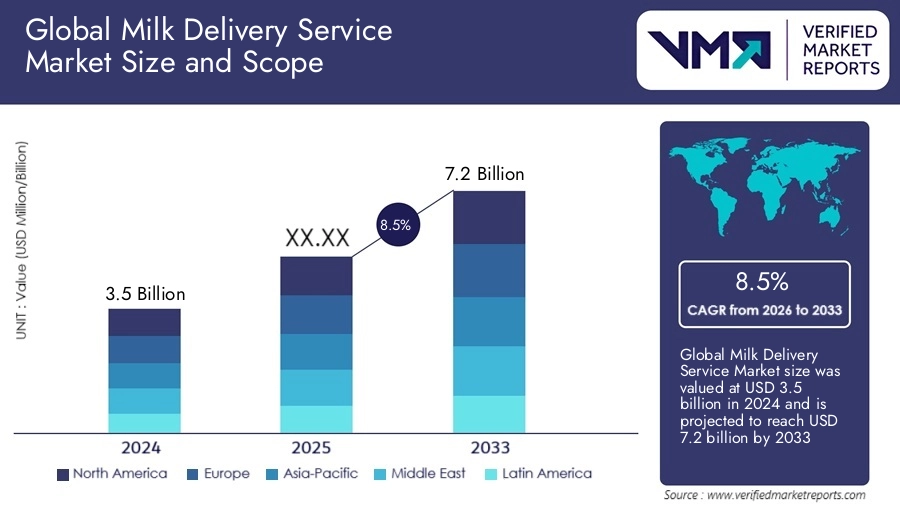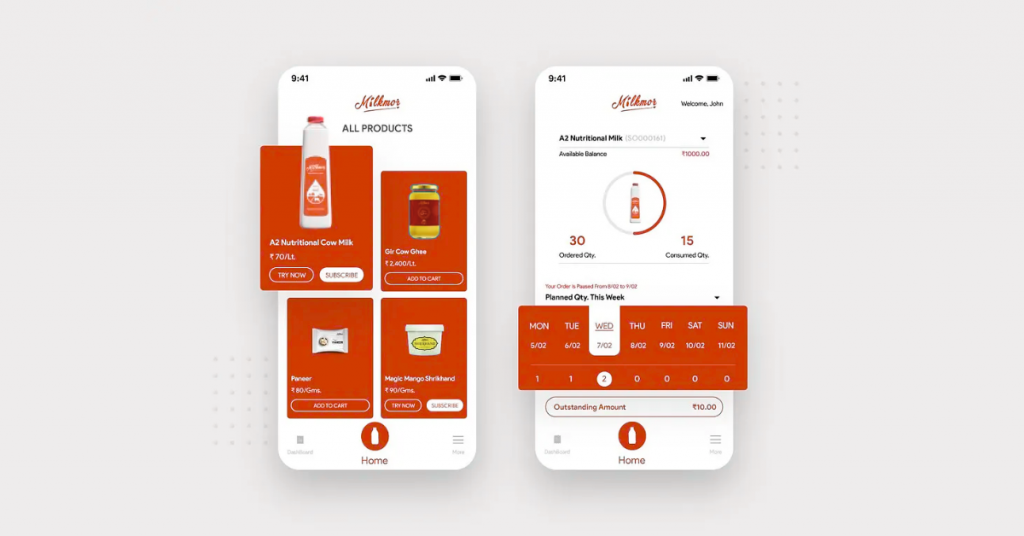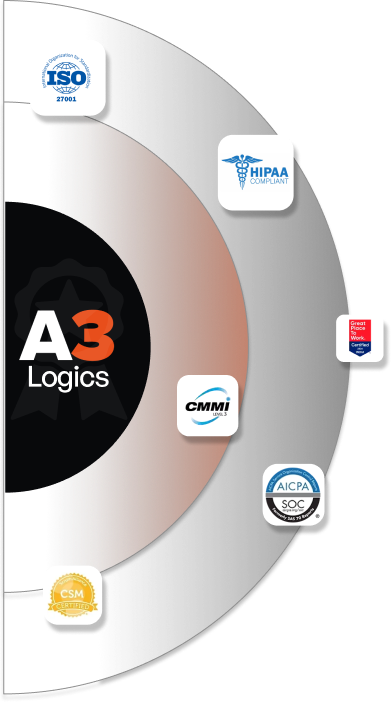Milk Delivery App Development: Gone are the days when people stood in queues at local dairies every morning or visited grocery stores to purchase milk and other dairy items. Furthermore, they also had to carry the purchases all by themselves.
Today, life has become very busy. People hardly have time to breathe, let alone visit a store early in the morning just to pick up daily milk and essentials. That’s where milk delivery apps have made lives easy that offer sheer convenience by offering timely delivery dairy essentials right at doorstep.
Enter the lucrative opportunity for milk delivery app development—a smart solution to meet rising consumer expectations and transform how dairy businesses operate. This post covers everything you need to know about milk delivery mobile app development—from features to tech stack, benefits, and monetization.
Table of Contents
What Is a Milk Delivery App?

A milk delivery app is a mobile application through which users can order milk and other dairy products and have them delivered to their doorstep, thereby eliminating the need to go to a grocery store. It connects users with daily farms or suppliers, facilitating efficient and convenient purchases of milk and dairy products.
How Does the Milk Delivery App Benefit Users?
- Users can browse and purchase milk and dairy products from the app. Some apps specialize in connecting customers with local farms, offering farm-fresh and organic dairy products.
- Schedule deliveries at desired time and place.
- Pay for purchases using secure payment gateways.
- Track the progress of orders; find out when their order will be delivered or where it has reached.
Why invest in developing a milk delivery app?
As an investor you may, for once, wonder – why invest in milk delivery mobile app development? What is in it for me?
As someone who sees value in everyday convenience and wants to explore digital growth, investing in milk delivery app development can lead to a steady income and loyal users. You could be a startup founder in foodtech, a venture capitalist focused on consumer apps, or someone who wants to modernize and scale dairy operations, or the like, investing in milk delivery app development can be a great move in a market where consumers are looking for convenience and quality.
Let’s have a look at why you should invest in milk delivery app development –
> Capitalize On Recurring Demand
The global milk market is growing and offers an excellent opportunity to capitalize on recurring demand and digital convenience by developing a milk delivery app. Milk and dairy products are essential, and users are likely to purchase them regularly. The milk delivery app, therefore, presents a consistent income stream.
> Streamline Dairy Operations Easily
As a business owner, someone looking to streamline dairy operations such as inventory management, delivery logistics, quality assurance, customer engagement, a milk delivery app can be a great tool. You can streamline the entire delivery process from the convenience of your app; thereby, reducing costs and improving operational efficiency.
> Ensure Quality Assurance
Using technology, you can ensure quality assurance, ensuring that products are fresh and apt stocks are maintained. You can further ensure that at every stage, no items are harmed, and strict measures are in place to keep the products fresh.
> Gain First Mover Advantage
In some areas, there may be limited competition as there are no milk delivery apps or minimal milk delivery apps. In such a market, you can gain a first-mover advantage.
> Sell Not Just Milk But Other Necessities
Not just milk: By developing a milk delivery app, you can easily scale to other necessities such as bread, eggs, yoghurt-related items, cheese, groceries, and other dairy products.
> Analyze Valuable User Data For Better Marketing
Collect valuable data about customer behavior patterns, preferences, delivery routes, etc. this way you can create better marketing strategies and enable better decision making.
> Use the Expertise of A Seasoned App Development Company
Even if you have an idea for a milk delivery app but don’t have the expertise, you can partner with a milk delivery app development company to turn your vision into a full-fledged platform, built with the right tech stack, right features, and is market fit.
Understand Milk Delivery App Market Size

- It is projected that global milk production will reach 227.2 billion pounds by 2025
- The dairy food market size is expected to reach $1374.37 billion by 2030.
- Revenue in the milk market is expected to cross $27 billion in 2025 and is further expected to reach the $40 billion mark by 2029.
- Apps like MilkBasket serve over 5 million homes.
- The global online milk delivery market is booming and is projected to reach $25.8 billion by 2032.

Different Business Models of Milk Delivery Apps
Yes, indeed, the milk delivery app will eventually cater to customers’ needs, but it also needs to help a business earn money. A steady income stream would help keep operations going and generate profits. Here are some common business models for milk delivery apps –
1. Subscription-Based Revenue Generation Model
In this revenue model, customers can subscribe to daily, weekly, monthly, or annual milk delivery plans. You can offer your customers the option to modify, pause, or resume their plans as they desire. Additionally, you can offer subscribers priority slots, exclusive products, discounted rates, and other incentives for subscribing to your milk delivery platform. This revenue model can help generate a steady stream of income and, at the same time, help retain customers.
2. Ad-Based Commission from Dairy Brands
In this revenue generation model for your milk delivery app, you can allow local dairies to list their products on their app. You can then charge a commission per sale. Under the commission model, you can also let the dairy brands feature their products as ads at noticeable sections of the app (for instance, on the top of the app) for specific fees. The ads can be in the form of featured products, banner ads, or top search placements.
3. Offer Targeted Promotions To Partner Brands
You can charge brands by offering them targeted promotions. Here, you’ll show their offers to the users who are most likely to be interested. For example, assume you are conducting targeted advertising for a brand that sells yoghurt. If someone regularly buys yoghurt, you can show them combo offers or discounts on the brand’s yoghurt products. This way, the promotions will reach a more relevant audience, leading to higher conversions, better engagement, and more return on the ad spend.
Here’s how you can make money –
- Charge the brand only when a customer clicks on the promotion.
- Charge brands based on how many times their ad is shown.
- Offer fixed-rate packages for running targeted ads for a specific period; great for special offers or product launches.
4. Monetize Convenience
If your products and services are good, your app users won’t mind paying up for convenience, and that’s where you can earn extra. You can charge customers based on peak hours, long delivery distances, and how quickly the customer wants the order delivered. For instance, you can add express delivery charges for customers who want their orders delivered fast. To encourage larger deliveries, you can offer free delivery (no delivery charges) when a customer makes purchases above a certain amount.
5. Utilize The Power of Cross-Selling
In this revenue generation model, your aim is not just to sell one product but also related items. For example, you can integrate a “Customers also bought” section where items that are bought alongside specific items are highlighted. For example, when a user plans to purchase a brand of sharp cheddar cheese, they will also see that a certain brand of macaroni pasta is highlighted.
Popular Milk Delivery Apps in 2025
Below is a list of some of the best milk delivery apps –
1. Milk & More
It is the UK’s oldest and largest online milk and grocery delivery service, serving over 1.4 million homes nationwide. Apart from milk, the platform also delivers bread, juices, cereals, and other groceries. All in all, the company delivers more than 200 products around the country through their app and website before 7 am.
2. Milk Club
The app helps connect customers with local farms and dairies. One of the highlights of the app is that it doesn’t just deliver cow’s milk but also favored milk, organic milk, oat milk ,and more. It offers flexible delivery schedules and lets users customize their orders. Users can order dairy essentials by brand preference and get them delivered twice a week.
3. Modern Milkman
The intent of the app is to provide its customers with high-quality, ethically sourced milk and other dairy essentials to their doorstep. The company works directly with local farms and hails sustainable and ethical practices. It has helped saved over 32 million plastic bottles from landfills with every consumer saving 100 on an average. The app is known to back independent professionals and community.
4. Instacart
Instacart helps getting grocery and food delivery orders directly to a customers doorstep in as fast as 30 minutes. Apart from ordering milk, customers can order a variety of grocery items including snacks, food and drinks from grocery stores in the vicinity. It also ensures safety by letting users opt for contactless food delivery.

How Does A Milk Delivery App Work?
Now that you have a brief idea of what a milk delivery app is, the different business models, the leading popular milk delivery apps, and why investing in one is a good idea, let’s dive a little deeper and understand how it works.
We shall break this down in two parts – we’ll discuss how a milk delivery app works for a mobile user (customer) and how it works for the milk vendor.
How The Mobile Delivery App Works for Customers
> Onboarding Milk Vendors and Customers
When setting up a mobile app for milk delivery, the first step is to have milk vendors and customers sign up. They can do that via social media, emails, etc. As a part of the registration process, they are expected to input their basic information, such as name, phone number, address, payment preferences, etc.
> Customers Can Start Browsing
Once customers and milk vendors have registered on the mobile app for milk delivery, customers can start browsing for dairies and milk sellers in their area. Users can also use the universal search bar to filter milk sellers. Next, customers can start adding milk and other dairy products like cheese, yoghurt, butter, etc, to the shopping cart, finally proceeding to the checkout process.
> Make Payment
Once customers have finalized the items they wish to purchase, they can choose from various secure payment methods – online payment, cash on delivery (pay on delivery), payment via debit/ credit card, cash wallets, etc.
> Order Confirmation
The next stage, as a customer makes the payment, the order is confirmed and dispatched for delivery. The customer also receives a notification stating that the order has been confirmed. The user can also track the delivery typically using the order ID, estimated delivery timing, and order summary. Most apps for milk delivery these days also let users track the movement of delivery in real-time (known as live tracking system).
How The Mobile Delivery App Works for Milk Vendors?
> The Milk Vendor is Notified
As soon as the order is placed, the milk vendor is notified. What happens next is a complete process. The milk vendor first accepts the orders, after which they prepare the products for delivery. During this time, a driver who will approach the vendor’s location and collect the order for delivery is dispatched.
> Milk Delivery Management System Comes Into Play
At this stage, the driver picks up the order from the milk vendor and leaves to deliver at the customer’s location. To ensure that the order reaches the customer on time (or in optimal time), the milk delivery management system selects the best route, using which the driver can quickly reach the customer’s location. Sometimes, the system might reroute the driver if the route is congested with traffic. The customer is constantly notified of the delivery progress, and they can also view the driver’s location in real-time via GPS systems integrated in the app.
> Driver Drops Off The Package At Customer-Chosen Location
Mobile apps for milk delivery let customers choose where they want the package to be left, especially if they opt for contactless delivery.
The Next Steps – Customer Feedback and Retention
> Feedback System
Once the complete order booking and delivery process commences, customers are directed to a feedback page. Here, they can provide feedback on various aspects of the delivery, both by giving stars and leaving detailed feedback. They can also provide feedback on the service, the product delivered, the driver, and the app (the aggregator of the milk delivery process).
> Customer Service
Milk delivery apps also have redressal systems for issues such as refunds, cancellations, and grievances. These systems ensure that issues are resolved in a timely and satisfactory manner.
> Subscription Management (For Vendors)
To retain customers, milk vendors can utilize the milk subscription management system under which subscribed customers can be incentivized with free deliveries, discounts, and other rewards.
Key Features of Milk Delivery App

1. User-Friendly Interface
An important feature of an online milk delivery app is a neat and clean user interface. The design should allow users to navigate, place orders, and access the other features of the app with ease.
2. Proper Systems for Quality Checks
Integrated quality and feedback check systems ensure product safety and quality at every stage – stocking, loading, and delivery. With a proper feedback system, customers can share their experience. You can use this feedback and other insights to improve user experience.
3. Extensive Product Catalogue
A milk delivery app’s product catalogue should be built in such a way that it poses no issues when a user browses it. It should be well categorized with clear categories for dairy and other essentials. Each item should have relevant and to-the-point descriptions, prices, and other aspects.
4. Variety of Filters To Narrow Down The Search
Filters are important in a milk delivery app as they help users find the exact product they want from an extensive catalogue. Using filters specifying particular criteria, users can narrow down their searches by aspects such as product type, brad, price, location, quantity, packaging, and several other factors.
5. Robust Security and Scalability
Integrating robust security will ensure that unauthorised parties cannot access your users’ (customers, vendors, and other parties) confidential data, their selling or purchase history, location data, transaction, and other details. Milk delivery app developers should prioritize secure payment gateways and robust data encryption and adhere to relevant privacy and payment regulations.
To further ensure that the app can handle increasing user loads and transaction volumes, it is essential to design the app with a scalable architecture optimized to deliver fast loading times.
6. Alerts and Notifications
Instant alerts and notifications updates the involve parties of the order delivery status. Plus, you can alert users regarding special offers, promotions and discounts.
7. Real-Time Tracking
Real-time tracking lets customers track or monitor their deliveries as they happen, live in real-time. They can see the exact location of the delivery, check estimated time of arrival, get notified at each stage, etc. This feature maintains transparency between users and vendors. To incorporate real-time tracking, GPS systems and mapping APIs should be used that sync delivery data to the app.
8. Multiple Payment Methods
You can provide multiple secure payment methods at the checkout using which users can complete their transactions.
9. In-App Chat
Through this feature users can communicate with each other. The in-app chat feature open lines of communication between customers, suppliers and delivery providers. For example, customers can chat with vendors and riders and vice versa.
Benefits of Milk Delivery App Development
We have established how milk delivery apps increase convenience in purchasing dairy essentials. Let’s look at some of the benefits of milk delivery app development.
In this section, we won’t just look at how a milk delivery app is going to benefit end users but also how, as a platform, you can reap benefits as well –
> Save Time and Increase Convenience
By developing a milk delivery app, you can save your users those last-minute grocery runs. With a few taps, users can order dairy essentials right at their doorsteps.
What Is In It For Me?
This value addition would translate to deep customer satisfaction thereby increasing retention on your milk delivery mobile app. Needless to say, your platform will grow organically.
> The Facility To Schedule Orders
Milk delivery apps let users schedule their orders. They can assign a date, time, and even location for their deliveries.
What Is In It For Me?
The functionality doesn’t just help in customer/user retention, but it even lets you understand future demands, and accordingly, you can plan inventory, logistics, staffing, etc. Furthermore, this can also reduce failed deliveries on your platform.
> Adherence To Quality Protocols
As a quality-focused milk delivery app aiming to build customer trust, you’ll only onboard verified milk vendors who follow strict food safety standards and ensure timely and accurate deliveries.
What Is In It For Me?
This helps in building trust and visibility of your app, and at the same time, you can steer clear of customer complaints/ returns (lower support costs), and also business disruptions and fines.
> Lucrative Subscription Models
As a milk delivery app, you can have various subscription models, which we discussed in the revenue-generating models. These subscription models allow you to offer users discounts, loyalty rewards, and several other incentives.
What is in it for me?
Subscription models can be your doorway to a steady stream of income. In addition to generating recurring platform users, these models also help you lower customer retention and acquisition costs and increase your cash flow, which you can later invest to grow your app.
> Real-Time Tracking
Through your milk delivery app, users know precisely at what stage their delivery is—whether it’s packaged or out for dispatch, etc. This gives them peace of mind and provides them with transparency that their order is on track and is handled with the utmost care.
What is in it for me?
By helping users track their orders in terms of real-time route tracking, order status, etc, you help increase user engagement with the app. The feature also helps you gain backend visibility into delivery agent movement and timing. You can make calculated, data-driven improvements and improve operations using these insights.
> Cross-Selling Opportunities
As far as milk online delivery app development is concerned, your platform can be a place where you can sell an exhaustive list of dairy products that fit a user’s dietary needs and tastes.
What is in it for me?
By adding the cross-selling feature, you can connect the milk delivery app with other brands and sellers who might pay you to promote their products within your app.
Step-by-Step Guide to Developing a Milk Delivery App
Step 1 – Conduct Thorough Market Research
Just like any app, the first step of the milk online delivery app development should begin with thorough market research. This will help identify the target audience and analyze the existing competitors and how they are gaining success. Furthermore, you can identify the exact features you will include in the app and tailor them to customer satisfaction.
Step 2 – Choose An Apt Business Model
Next, decide how you want to monetize your app. We already have a dedicated section where we have discussed several business models in detail. You can choose the one that fits your needs. Also, creating a POC or proof of concept at this stage can prove to be beneficial.
Step 3 – Identify The Features That You Want To Include In The App
Identify the core features that you want to include in the app. If you are exploring features that will help you build a successful mobile app for milk delivery, you can get in touch with an on-demand app development company that would recommend proven, high-impact features based on industry trends, user behavior, and successful app models that they have tried and tested before.
Step 4 – Choose The Right Technology Stack
Choosing the best technology stack is essential for milk delivery mobile app development. The right tech stack simplifies app development and ensures everything works harmoniously. Here’s the kind of tech stack you should use when building an application for milk delivery –
| Mobile Platforms | Android and iOS |
| Backend Development | Node.js, PHP, or similar frameworks. |
| Front-end Development | Flutter, React Native, or other frameworks for building user interfaces. |
| Cloud Services | AWS, Google Cloud, or Azure. |
| Databases | MongoDB, PostgreSQL, or other suitable database technologies |
| Secure Payment Gateways | PayPal, Google Pay, Apple Pay, and e-wallets |
| Push Notifications | Push.io or something similar |
| Real-time Tracking | Google Maps API, GPS |
| Security | SSL, encryption, and other security measures. |
Step 5 – Designing An Intuitive UI/ UX
At this stage, you design an intuitive and user-friendly UI/ UX for your milk delivery app. To achieve the right look and feel, you design the app’s layout, navigation, and visual elements to provide a seamless user experience.
Step 6 – Develop The Backend
Develop the backend of the milk delivery app, focusing on building the server-side systems required to keep the app running smoothly, such as order processing, product catalog, delivery logistics, and integration with external services.. This stage involves building databases and APIs that will power the application. We already have a section discussing the tech stack for the backend development of a milk delivery app.
Step 7 – Develop The Frontend
In simple terms, the front end is how users interact with your app. Here, the focus should be on coding intuitive screens for placing orders, browsing products, managing subscriptions, tracking deliveries, etc. At this stage, you must develop a frontend that’s lag-free and responsive, something that can work well on a variety of devices. While we suggest that you create a cross-platform app, in case you have decided to choose a single platform for app release, you can take the assistance of an Android or iOS app development company.
Step 8 – Launch The Application
Once the app is ready, there is still some work to do before launching it on platforms like Google Play (Android), or the App Store (iOS). Let’s break down the application launching step into two parts –
- Integration and Testing
Prior to launching the app, it must go through several rounds of intensive testing. During this phase, various aspects of the app are tested such as performance, app’s functionality, security and many others. It is also ascertained if there is a seamless integration between the app’s frontend and backend. If any bugs, errors or flaws are detected, they are removed in this phase.
- Deployment and Maintenance
Once you are sure that the app’s functioning perfectly and that there are no security loopholes, release it on popular app stores like the Google Play, and Apple App Store. And, even after the ap is launched, regularly check it for issues and release new features.
Factors Affecting the Milk Delivery App Development Cost
The cost of developing a milk delivery app differs based on factors like the ones mentioned below, and ranges from $20000 to $50000 or more (based on requirements).
1. Complexity of Features
The more complex the features, the more the cost of the milk delivery app development. For example, integrating third-party tools like Push.io, Google Maps and GPS technologies alone can increase the app development cost. Other important features like inclusion of various subscription models, in-app payments, real-time order updates and advanced analytics can also add to the cost of development since these increase the billable hours of developers as these need extra hours and effort.
2. Choice of Platform
Choosing the platform for milk delivery app development can impact the cost of development. If you choose to develop apps for individual platforms (separate apps for Android or iOS), you’ll need a separate code base, development, testing and maintenance for each platform. This would involve more time and resources and thereby increase the overall cost. Cross-platform apps, on the other hand, allow you to build one single app using a shared code base, which would reduce the overall development time and cost.
3. Testing and Quality Assurance
To ensure that your app is free from errors, it has to go through a systematic process of testing and quality assurance, and the same can add to the cost of developing a milk delivery app. That’s because this process requires skilled testers who would further require multiple testing tools to simulate real life user scenarios. At the same time, they would also be required to invest a considerable amount of time.
4. Post Launch Maintenance and Support
Developing a milk delivery app is not a one time affair. Even after deployment on popular app platforms, you’ll need to spend monthly or on a regular basis on maintenance, app updates and tech-support. This cost is necessary so that the app stays free from bugs and issues that can otherwise hamper user experience. Upgrading the app with new and trending features will ensure that the app stays relevant in the market.
5. Choice of Tech Stack
There are many tech stacks that are free and open source, yet to design a modern milk delivery app that conforms to modern tech needs, you may have to include AI-based features; AI-powered integrations and hosting, both of which can add on to the development cost.
Please note: The cost of developing a milk delivery app will vary based on your business needs. In case you want to get an estimate, you can get in touch with a mobile app development company.
Milk Delivery App Development with A3Logics
As we mentioned before, if you have a concept in mind for a successful milk delivery app but are unsure of how to get the development started, you can partner with an on-demand mobile app development company. A3Logics, is one of the best companies that has carved a niche in food delivery app development.
Some Reasons to choose A3Logics To Develop Milk Delivery Mobile App
- Custom Solutions for Every Business Model: Whether you’re running a local dairy or a subscription-based delivery service, A3Logics can tailor the app to fit your business perfectly.
- Advanced Features Made Simple: From smart AI recommendations and easy order scheduling to voice-enabled assistance, they help you build a modern, user-friendly app.
- Powered by Next-Gen Tech: A3Logics uses cutting-edge technologies like AI, IoT, blockchain, and cloud to create innovative, future-ready solutions.
To know more, book a consultation call today!
Conclusion
In this post, we’ve touched upon everything you need to know about milk delivery app development – features you can integrate, revenue generation models, steps involved in developing the app and the factors affecting its cost. So, whether you are just exploring the idea or are ready to get started, this guide will give you clarity and the right direction.
Sure, milk delivery app development requires an upfront investment, but with the right tech resources and strategy, you can build a high-performing app that’s not just sustainable—but truly rewarding.





